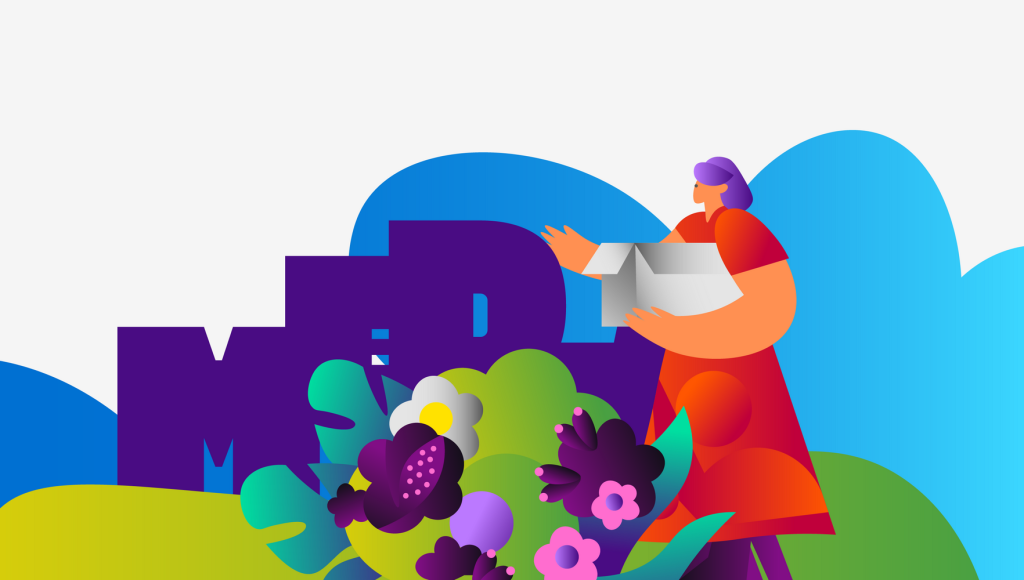
Media Buying: Types, How It Works and Tips for Making the Most of It
When the COVID-19 hit, businesses reduced spending on marketing, but with the pandemic restrictions behind us, budgets have started to climb back. Gartner’s annual survey reveals that marketing budget share has increased by 3% since 2021 reaching 9.5% of company revenue. And growing budgets mean more work for media buyers. Challenging times are not over though, and budget optimization is still a priority. In this article you will find some practical advice on how to get ads that drive value for an optimal price.
What Is Media Buying?
In simple terms, media buying is the process of buying advertising space and time. This definition captures the overall essence of the term. It involves procuring ad space on digital and offline channels your target audience interacts with at the best price possible for the best ROI.
Ad placements should be used correctly to be effective. When choosing a channel, either traditional (offline) such as magazines, newspapers, television, radio, and out-of-home advertising, or digital, a business must be clear on its objectives. For media buying to be successful, there has to be a well-formulated strategy that aligns with the company’s overall marketing goals.
What Is a Media Buyer?
Media buyers are marketing professionals who oversee the media buying process and work closely with the media planning team to formulate the media buying strategy for a brand.
Communication skills are crucial for this position, as a significant part of media buyers’ tasks are negotiations. They negotiate with publishers to buy ad placements in any channels or networks, which may include press, TV or online spaces where they want ads to appear. They help secure the best placements at any given time for the best price.
Media Buying vs Media Planning
Both are important processes in marketing. While there might be some overlap between the two, there are clear differences.
Media buying focuses on purchasing advertising that will bring the most impressions from the target audience at the lowest cost possible. And media planning is about developing the overall marketing strategy that drives the advertising campaign. Planning comes first and covers a wide range of marketing activities including the use of owned media, that a business doesn’t pay for, like push notifications from brand’s app or website.

How Does Media Buying Work?
The media buying process is not as complicated as it might seem at first glance to the occasional advertiser or a newbie in advertising. Typically, it would involve:
- Reviewing the media plan and developing an appropriate media buying strategy.
- Deciding how much you want to spend on a campaign and what you want to spend it on, i.e., a guaranteed inventory or a non-guaranteed inventory.
- Conducting media research using research tools built for each channel you want to use.
- Sending out requests for proposals (RFPs) to the channels that will deliver the best results for your marketing strategy.
- Submitting an insertion order (IO) to the chosen media outlets (not applicable to programmatic buying).
- Implementing advertisements.
- Tracking the performance of implemented ads.
- Reconciling costs with ads.
- Generating campaign reports.
Types of Media Buying
Media buying can be done in two major ways. They are:
Direct Media Buying
Direct media buying involves finding an advertising publisher, negotiating and buying ad inventory, and displaying the ad on the chosen place. This is a manual process that involves negotiating from scratch with each publisher.
On the one hand, direct media buying can be good as the selection of ad inventory is custom, and it is based on special consideration of the audience. On the other hand, the process is slow and can be expensive.
Programmatic Media Buying
Programmatic media buying is done using AI-powered tools. Bidding occurs on ad spaces that match consumer profiles to leverage the best platforms your target audience is most likely to use. The process involves buying ads through real-time bidding, where the highest bidder gets the inventory slot. There is minimum input from the media buyer in this process.
Programmatic advertising can be an effective and relatively cheap way to reach your target audience, yet it’s not without disadvantages. Accurate targeting, which is one of the main reasons why brands actively use this type of ads, is very likely to be negatively influenced by the phase out of third-party cookies. Another drawback is money loss. According to an ISBA Study, only half of the paid amount goes to the publisher, another 35% cover fees to the agency and numerous platforms, and 15% simply disappear somewhere in the process. In monetary terms it is over $22 billion. Ad fraud is another major problem, especially in North America. It is important to work with reliable publishers to make sure your ads are viewed by real people and not bots.
Despite the disadvantages brands continue investing in this type of marketing and in 2022 brands are expected to spend over $122 billion on programmatic advertising.
There are three main components to programmatic media buying:
Demand Side Platform(DSP)
A DSP is a tool advertisers and agencies use to set up advertising campaigns. The tool automatically buys ads from multiple publishers in real time. There is no need to spend time negotiating prices on a DSP; the system allows you to optimize your ads based on set key performance indicators.
Supply Side Platform (SSP)
An SSP, on the other hand, is a tool publishers use to manage, optimize and sell available ad inventory through real-time bidding (RTB). A publisher sets a floor price for available ad inventory, and the advertisers make bids for it on the platform.
Ad Exchange Marketplace (RTB)
An ad exchange marketplace is a neutral, autonomous digital marketplace where ad inventory is bought and sold through real-time bidding. There are three main types of ad exchanges: open ad exchange, private ad exchange, and preferred deal.
It should be noted that you can also buy impressions on private marketplaces (PMP), where the publisher controls who can participate in the bidding process, and programmatic direct, where ad inventory is sold at a fixed cost-per-mile.
Also, ad exchanges should be distinguished from ad networks which are platforms that collect ad inventory from publishers to sell to advertisers, acting as an intermediary. A popular example is Google Adsense.
With the right approach and a reliable publisher, programmatic ads will become a valuable element in your marketing mix.
What can a Media Buying Pro Do?
Now that we know what media buying is and how it works, we will look at benefits that an expert can guarantee. That’s what you get if the media buying process is well-organized and performed by real professionals.

The Best Deal
Negotiation is a huge part of advertising media buying. With the right media buying team, a business can get the best deals on advertising at a reduced cost. Media buyers leverage their relationships with publishers to negotiate fair prices. They are also aware of the industry trends and practices and can use this to their advantage.
The Best Ad Placements
Media buying is also instrumental in getting brands the best slots there are. Media buyers know which ad placements generate the most engagement and how trends and events interact with advertising campaigns. They use this knowledge to get the best slots for any given time.
Better Returns on Investment
Even if it’s important to buy more ad media for the lowest price, an expert always remembers that it’s the value generated by the purchased ads that actually counts at the end of the day. Equipped with an advanced media mix modeling solution, marketers will make data-driven decisions on what channels to include in the marketing mix and how much to spend to get the highest ROI.
Media Buying Challenges
The following aspects require extra attention, because if overlooked, they will result not only in wasted budgets but also damaged brand reputation.
Ad Fraud
When it comes to performance advertising, work only with reliable publishers that use AntiFraud solutions. Otherwise all the views your ad gets could as well come from spam bots.
Brand Safety
Make sure that your advertising is shown in the appropriate context. If a premium brand advertising appears in an unsafe environment, it might lead to reputation damage. This problem is also usually associated with programmatic advertising, so choosing direct deals will help you avoid situations where your ad appears in negative content.
Performance Measurement
Statistics on media placements are quite easily obtained, but only reputable providers who use anti-fraud solutions can guarantee that your ad was viewed by real people and that the numbers are true. Anyway simply by looking at the number of views, clicks or impressions you cannot understand if the purchased ads were effective. That is why you need advanced analytical tools that will help you attribute the business results like sales or the number of new customers to the money you spent on media channels. With such solutions media buying and planning processes become much easier and efficient. Check out these three AI-based solutions for marketers that can show you which channels contribute to KPIs and which ones are wasting your money.
Tips to Make the Most Out of Your Media Buying Strategy
Use AI-based services
AI can help streamline and optimize the media planning and media buying processes, enabling advertisers to make data-directed decisions and achieve better results. You can use an automated AI service by CheckMedia for preliminary evaluation and planning of the go-to-market strategy. In order to use the service, you will need to provide five crucial inputs about your go-to-market plan. The service will use this information to determine whether you have sufficient marketing budget to execute your strategy, answering a question that is vital to your success.
Ask the Right Questions
Before starting any media buying process, you must ascertain what you want from that campaign. What is the overall goal of the campaign? Is it website traffic or brand awareness? What is your budget for the campaign, and what channels are you willing to spend money on? Answering these questions will help you strategize properly.
Identify Your Target Audience
You need to determine your target audience for your advertising to be successful. You might do everything right with your campaign, but if your campaign is appearing to the wrong people, then there will be no point in it. The type of business will largely influence who the target audience is.
Plan and Research
You need to align your goals with your actions, and this is where developing a media buying strategy comes in. Research extensively to determine what the best course of action, platforms, and media channels will be for your brand based on key factors such as
- The metrics that will be used to measure the campaign performance
- The possibility of fraud and the levels of transparency on your chosen platforms
- The types of contracts that you are willing to commit to
Use tenders
Run a tender to select an agency with the best offer. Agencies usually have extra discounts and volume bonuses on some media purchases. It is especially relevant for non-programmatic / performance channels.
Negotiate for Clear and Flexible Contracts

When discussing what you are going to get under a media deal make sure to clearly fix everything in the contract in writing, including all purchase conditions, campaign geography, prices and ad slots. Later on it will be easier to check the actual prices and ad media for compliance with the conditions you had agreed upon. Find out what bonuses you can get from publishers and include those in the contract too.
If you have advanced analytical capabilities that can analyze campaign performance while it is still running, your media deals should be flexible enough to allow for in-campaign changes. This can be only applied to digital media. If you are not sure what other details to cover in an agreement, you can use templates provided by reliable sources like ANA.
Track Results
The only way to know whether something is working is to measure it. Always track the performance of your campaigns so you can know whether to go a different route in your next campaign. Use the same metrics you used in creating the media buying strategy to measure your results.
Carry out Media Audits
Independent auditing helps to find out whether the services you get from your agency result in the best performance. Whether you have enough access to accounts and campaign source data.
Automate and Utilize Tech Tools
Manual media buying can be expensive and time-consuming. Save yourself some stress and automate the process. It would help if you also used tech tools to perform some advertising media buying processes. For example, there are specialized tools for conducting research for the different media channels.
One of the recent technological advancements that may come in handy for media buyers is ChatGPT. It can assist in campaign optimization and help to reach and engage with the desired audience groups more effectively leading to better ROI. Chatgpt-4 can be used in media buying for the following purposes:
- audience targeting: ChatGPT-4 can analyze customer data and identify their preferences and patterns in behavior. This information can be used to target different audience segments with relevant messages. By using chatgpt-4 to develop more accurate audience profiles, media buyers can optimize their ad placements.
- creative optimization: ChatGPT-4 can be used to develop and test different ad creative concepts. It can generate a wide range of ad copy variations and evaluate their effectiveness in customer engagement. This can help media buyers to optimize their ad creative to improve engagement and increase conversions.
- ad placement: optimization ChatGPT-4 can be used to analyze customer data and identify patterns in customer behavior across different media channels. This information can be used to optimize ad placement across various platforms and devices. By using chatgpt-4 to develop more accurate media buying strategies, media buyers can increase the effectiveness of their ad campaigns and improve ROI.
- chatbot advertising: ChatGPT-4 power advertising chatbots. By training chatbots to engage with clients in a conversational manner, media buyers can improve engagement and create a more personalized customer experience. Chatbots can also collect valuable customer data and feedback necessary to optimize future media buying campaigns.
Keep an Eye on Competitors
While it is not advisable to copy what your competitors are doing with their advertising campaigns, keeping an eye on their actions is not a bad idea. Doing this will help you gain insights into what you might be doing wrong in your campaigns.
Be Patient
Lastly, but very importantly, be patient. Marketing is never a sprint. Depending on the strategy you are pursuing, you might have to wait for months before getting any tangible results. It doesn’t mean you should not buy media again.
Conclusion
In a world where consumers are inundated with so much information and ads, out of sight is literally out of mind. If you stop putting out messages for your consumers, another business will fill up the space.
Media buying requires a consistent and focused approach to be effective. Whichever media channels you choose for your business, you must keep sending a clear and distinct message to your audience.
The platforms, partners and publishers you rely on to execute your media buying strategy are just as important as the strategy itself. To get a good return on your spending, always invest only in reputable solutions, even if it means spending a little more.



